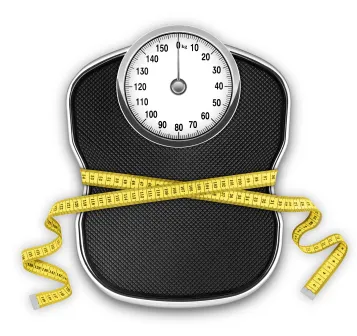
Low Carb Weight Loss
Fad diets come and go, but in my practice, I follow the science more carefully than I follow the fads. In doing so, I have been tremendously impressed with the work of Gary Taubes, who has meticulously detailed the science behind the low-carbohydrate diet trends. He is not alone. Other writers, scientists, and physicians have been validating the health hazards associated with excess carbohydrates – where our dietary consumption has increased over the last fifty years in direct parallel with the epidemics of obesity, diabetes, and malnutrition. Scientific trials have confirmed benefits from restricting the carbohydrates: weight loss as well as reduced diabetes and heart disease markers. Although there are some individuals who will do as well or better with a low-fat diet, more people will lose weight on a low-carb diet. This is not, therefore, the only way to lose weight, I have just found it to be the most widely successful plan.
For almost everyone, a low-carbohydrate diet is more satiating, sustainable, and complex in its nutrient density. Nothing foils a good diet plan like a healthy physiology looking for nutrients it can’t find. (January 2017 note: see my new article, Low Carb: Making It Real for some additional tips on making your low carb journey a successful one.)
DrDeborahMD’s version of the low carbohydrate diet therefore places high value on food quality, considering food origins and nutrient density. I offer you not just a diet, but rather a viable and sustainable food plan, ideal for weight loss and suitable for anyone. I am sharing with you essentially what I eat on a daily basis. Bon appetit!
Savor the Primary Foods: Proteins and Fats
Cook using any moderate heat source. No breading is permitted. Stop eating when you are full.
Protein: Every time you’re hungry, eat your choice of the following:
- Meat. Meat starts with beef, pork, ham, bacon, lamb, and veal. If you’re lucky enough to have a hunter in your life, it may also include venison, elk (lucky you!), and more for the truly adventurous. For processed meats, check the label; the carb count should be about 1 gram per serving. Grass-fed provides countless benefits (for you, the farmer and our world in general) over grain-finished meat and is well worth the extra expense if you can afford it. Please enjoy the fat on the meat, too; it aids in digestion, nutrient absorption and general physiological health.
- Poultry. Enjoy chicken, turkey, duck, and other fowl, with the skin.
- Fish and shellfish. Choose wild-caught salmon and other Monterey Bay Aquarium-approved seafood.
- Eggs. Eat as many whole eggs from pasture-raised hens as you like. Seriously: if you want 6 a day, eat them.
Fats and Oil:
Fats in general are important to include in your meals. A low carb diet (relative to what’s been advised) is a high fat diet.
- Healthful fats. All healthful fats and oils are allowed, including organic butter, even organic lard. Oils should be organic, cold-pressed. Avoid margarine and hydrogenated oils.
- Salad dressings. The ideal is olive oil and vinegar or lemon juice. Prepared dressings should be rare (usually contain genetically modified oils) and chosen to yield no more than 1-2 grams of carbs per serving. Avoid “light/lite” dressings.
- Frying. Use fats that are solid at room temperatures (e.g., ghee, coconut, and lard).
Foods to Eat Daily
The most common pitfall some folks encounter on a low-carb diet is constipation caused by unhappy probiotic bacteria (our microbiome) in our intestines. Our microbiome loves it when we chew on the fibrous stalk of asparagus, eating the tough chew parts of any vegetable we can find. At the very least, our guts are happy with a wide variety of low carbohydrate vegetables. So a high nutrient low-carb diet is not low-fat, it’s high fat and high vegetable. I often say my weight loss eating plan is actually plant-based, just because the largest part of your plate can pleasingly be filled with a variety of:
- Greens. Consume 2 cups daily (measured raw) of any leafy vegetable, raw or cooked. Cooked greens nourish best when eaten with melted butter or other fat.
- Vegetables. Eat 1 cup (measured uncooked) of artichokes, asparagus, broccoli, Brussels sprouts, cauliflower, celery, cucumber, eggplant, green beans, jicama, leeks, mushrooms, okra, onions, peppers, pumpkins, shallots, snow peas, sprouts (bean and others), sugar snap peas, summer squash, tomatoes, rhubarb, wax beans, or zucchini.
- (Bone) Broth Soup. Enjoy 2 cups daily to replace minerals. Homemade is best and allows you to modify salt content to taste and possible need for salt restriction.
You may consume additional vegetables ONLY if you are still hungry after first eating meat, poultry, fish, seafood, or eggs.
Foods Allowed in Limited Quantities
- Organic cheese. Consume up to 4 ounces of cheese, preferably raw, per day. Avoid processed cheese.
- Organic cream and butter. Enjoy as much as you want – the “limit” is that it comes after you get your nutrients from the foods listed above. Half-and-half is not cream, I’m talking about real whipping cream here!
- Mayonnaise: Use up to 4 tablespoons per day.
- Olives. Enjoy up to 6 black or green olives per day.
- Avocado. Eat up to half an avocado per day.
- Lemon/lime juice. Consume up to 4 teaspoons per day.
- Tamari. Use up to 4 tablespoons per day.
- Pickles. Enjoy up to 2 servings per day of dill (no sugar) pickles.
- Snacks. You can consume limited portions of sausage, pepperoni, other meats, and deviled eggs.
Avoid Problematic Foods
Easier said than done, to start with, but becomes easier with habit and success: avoid all nutrient poor, carbohydrate rich foods full of sugars and starches.
- All sugars. This includes simple carbs and starches (complex carbs). Sugar, honey, maple syrup, molasses, corn syrup, beer, milk, flavored yogurts, fruit, and fruit juices are prohibited. The only carbs to eat are the nutritionally dense, fiber-rich vegetables listed above.
- Starches. This category comprises grains, rice, cereals, flour, cornstarch, breads, pasta, bagels, starchy vegetables such as slow-cooked beans, (pinto, Lima, black beans), root vegetables, peas, and all potato products.
- Inflammatory oils. Soybean, cottonseed, and even celebrated canola oil, along with all the other “vegetable oils” cause inflammation, raise the risk of certain cancers and degenerative disease in general. Inflammation is a powerful factor in retaining excess weight.
Other Foods
Sweeteners and Desserts
- Stevia. Both stevia and erythritol are acceptable sweeteners. (Artificial non-caloric sweeteners are at the least confusing and at the worst hazardous to your body.)
Beverages
- Water. Drink as much filtered water, zero-carb seltzers, and herbal tea as you like.
- Coffee/tea. Enjoy up to 3 cups a day of coffee or tea. Green and white teas are richest in anti-oxidants. (Avoid using caffeine excessively if you feel groggy: see Support section below.)
- Alcohol. Avoid alcohol initially. As weight loss and new dietary patterns are established, low-carbohydrate alcohol (not beer) is permitted in moderate quantities.
Important Tips and Reminders
- Eat when you are hungry and stop when you are full. You are not counting calories. We recommend you start your day with a nutritious meal.
- The following are NOT on the diet: sugar, bread, cereal, flour, fruits, juices, honey, milk, yogurt, nuts, nut butters, canned soups, dairy substitutes, ketchup, sweet condiments, and relishes.
- Beware of fat-free or “lite” diet products and foods containing hidden sugars such as coleslaw or “sugar-free” cookies. Check the labels of all foods. Avoid products labeled as “great for low-carb diets.”
Diet Support and Problem Solving
While many people think, “Ahhhh, I’m home! And happy!” when they start a low-carb diet, some people may go through an adjustment period before feeling great. You can smooth the transition by doing the following:
- Do not skimp on fat. Fat aids with digestion, nutrient absorption, and brain function. Increasing fats is the first response to a groggy brain.
- Salt keeps your bowels moving. Adequate salt in your broth and food should help keep your bowels moving. If you have any constipation, choose one of the Thorne Research Magnesium products and take enough (usually 200-800 mg) to get things working again, then taper off as your body returns to normal.
- Consume unlimited quantities of probiotics and carefully add digestive enzymes. These can help your digestive system as you switch to low-carb eating. Probiotic Pearls (Integrative Therapeutics) are handy, non-refrigerated, and gentle. Start with 2 a day, increase to 4-6 daily as you like. Add Di-Pan 9 (Thorne), taken 1-2 capsules with each meal can be helpful if your digestion feels challenged by this eating plan. Adding lacto-fermented sauerkraut to your diet is the “food” way to provide these nutrients.
- L-Glutamine (Metabolic Maintenance). L-glutamine provides good brain food if you feel groggy on a low-carbohydrate diet. Take 500-10,000 mg in pill or powder (more quickly absorbed) form a day. Besides feeding the brain, L-glutamine will help keep your intestines healthy during the process of adaptation to a different diet.
- Apple Cider Vinegar. Sipping one-two tablespoons of apple cider vinegar before a meal will help keep your blood sugar from spiking after the meal.
- If you have any gall bladder problems, you may need extra support with bile salts as you add more fats to your diet. Eat healthy fats and protein together, chew thoroughly and walk after eating to enhance gut motility.
- Exercise. An exercise program helps you bypass insulin resistance (temporarily after a good workout), rewire fuel distribution to increase muscle rather than fat, and achieve general well-being. If you are hungry after exercise, remember that it is not a calories in, calories out situation. Any time you are hungry, you must eat by the same standards as at other times: Eat when you are hungry, start with proteins, add greens or vegetables and fats, and stop when you are full. After an hour of serious exercise, however, you probably have an hour when a few normally avoided carbohydrates are permissible.
- Athletes in training may need to add in some starchy carbohydrates if they find their mood, sleep, or training abilities diminished on a low-carb diet. For athletes, some complex starchy carbohydrates (half a sweet potato or delicata squash) or low-carbohydrate fruits (berries, citrus) can be added at two times of the day: directly after exercise, and/or late afternoon to evening. A bit of fruit (or even honey) right before bed can help the body’s natural melatonin producing process.
From Dr. Deborah’s Desk
(Please see other notes in our Obesity and Weight Loss topic.)
The high nutrient, low carbohydrate eating plan described here has made a world of difference within my family, among my friends and throughout my practice. What jump started me was squeezing uncomfortably into a bathing suit on that trip to Mexico, and now I’m getting to enjoy all those jeans and belts I had relegated to a forsaken corner of my closet.
Many people ask if this diet plan is life-long or just life-changing, and the answer is different for everyone. Some folks truly find themselves happier eating this way. For others, adding back in a few carbohydrates, after stabilizing at a good weight, is an easy step to monitor and reverse if necessary. Belt feels a little tight? Back on the plan. Everything fine for a while? A beer with dinner! (I choose organic, unpasteurized beer, rich in fermentation products that contribute to healthy bones. Even beer can have a nutritional benefit if you know what you’re looking for.)

